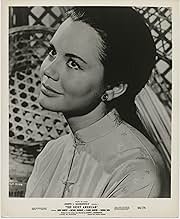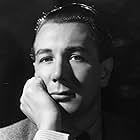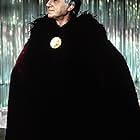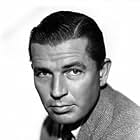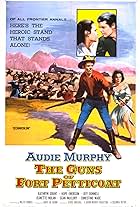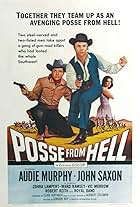IMDb RATING
6.6/10
2.2K
YOUR RATING
A young naive American and a cynical older British diplomat disagree over politics in 1952 Vietnam and over a beautiful young native girl.A young naive American and a cynical older British diplomat disagree over politics in 1952 Vietnam and over a beautiful young native girl.A young naive American and a cynical older British diplomat disagree over politics in 1952 Vietnam and over a beautiful young native girl.
- Awards
- 1 nomination total
Georges Bréhat
- French Colonel
- (as Georges Brehat)
Vo Doan Chau
- Cao-Dai Commandant
- (uncredited)
Le Van Le
- Cao-Dai Pope's Deputy
- (uncredited)
Cho Cha Lung
- Hotel Waiter
- (uncredited)
- Director
- Writers
- All cast & crew
- Production, box office & more at IMDbPro
Storyline
Did you know
- TriviaThe first Hollywood movie made in Vietnam.
- Quotes
Inspector Vigot: You know that it is a mistake to say that communism is appealing to the mentally advanced. I think it is only true when the mentally advanced are also emotionally retarded.
- ConnectionsFeatured in Dangerous Edge: A Life of Graham Greene (2013)
Featured review
I've now seen the two versions of this movie, based on this Graham Greene's novel. Though the 2002 version with Michael Cain and Brendan Fraser is supposed to be more faithful to Green's novel, I much prefer the story that is presented in this 1958 version. On TCM, Ben Mankiewicz said that, for marketing reasons, the story in this version (directed by his uncle) had to be toned down to make it less anti-American than the novel. He also said that Audie Murphy was probably chosen for the title role because he was a well-known actor-war hero (a Congressional Metal of Honor winner who played himself in the autobiographical war movie, To Hell and Back.) Though this wide-screen, black-and-white movie about two men in far-off place, called Vietnam, then failed at the box office, the locale of its story would come back to haunt us for decades to come.
Neither Audie Murphy nor Brendan Fraser stand out as actors that we tend to think of a 'top-notch.' But, ironically, the acting of the movie's title character doesn't need to be particularly great, just adequate. Both versions of this movie are more about THE MYSTERY of quiet American, Alden Pyle and what he is doing in Vietnam in 1952, than they are about the characters themselves. So, Audie Murphy (and Brendan Fraser in the 2002 version) only had to basically 'show up' in the movie to have the story work well. BUT FIRST, let's consider the plot of the 1958 movie, with cross-references to the actors that played the same characters in the boring 2002 version.
As the movie opens, the people of Saigon are in the streets celebrating the Chinese New Year (Tet) with parades of noise makers, masks, and paper dragons. During the celebration, a Vietnamese man discovers the body of a white man, lying face down in the river. The body is that of Alden Pyle (Audie Murphy)(Brendan Fraser in 2002 version). Police Inspector Vigot (Claude Dauphin)(Rade Serbedzija in 2002 version) calls in a British journalist, Thomas Fowler (Michael Redgrave)(Micheal Caine in 2002 version), to identify the body. Fowler is also questioned about HIS whereabouts at the time of the suspected murder. At this point, there is a flashback that takes Fowler's recollections back to when and how he first met Pyle and what their relationship had been like during their acquaintance...
Basically, they met since they were both white men working in an Asian country, and they tended to go to the same social clubs and restaurants to relax with other English-speaking people. When Pyle first meets Fowler, Fowler is accompanied by his live-in Vietnamese girlfriend, Phuong (Giorgia Moll—Do)(Thi Hai Yen in the 2002 version). While dancing with Phuong at one of the European clubs, Pyle is taken with her. When Pyle learns from Fowler that he is separated from his wife (who still lives in England and refuses to give him a divorce), he honorably tells Fowler that he wants to openly court Phuong. Fowler reluctantly offers to translate (English to French) Pyle's intentions to Phuong. Pyle tells Phunog that he loves her and wants to marry her and take her back to the US: he wants to offer her a future, away from Vietnam. This is something that Fowler—as a married man--can't do. But, Fowler deeply loves Phuong and wants to continue to life with her in Vietnam. The tension of the love triangle is heightened because Phunong's older sister is trying to look out for Phunong's future by hooking her up with the idealized 'rich American man from New York.' The fact that Pyle is neither rich nor from New York is only a minor problem for Phunong and her controlling sister. So, Phunong does leave Fowler for Pyle (respectfully living apart while courting).
As a journalist looking for a story to keep his job in Vietnam, Fowler travels to Hanoi in the North. There, there is a Communist offensive against the French. When he arrives in the embattled North, he is surprised to find Pyle there too. But, why would Pyle there when his business is plastics? What do plastics have to do with an offensive in the North? Pyle tells Fowler that he just came up to see him and see the action for himself, but why? As the two return home in a jeep, they breakdown on the road and are attacked by Communist forces. Pyle then saves Fowler's life, and they return safely to Saigon.
While Fowler is ready to believe the worst about Pyle's third force, a fellow British reporter puts him in contact with a Vietnamese friend. The friend leads him to think the worst about Pyle and his reason for being in Vietnam. (Plastics are used in toys but they are also use in explosives.) When circumstantial evidence confirms the Vietnamese contact's incriminating evidence against Pyle, Fowler's ideas only seem more solid. The final outcome of this movie reveals more about Fowler and Pyle, and it has a quirky twist to it.
In spite of what other reviewers and critics have said about THIS version of Green's novel, I find it far superior to the later, more true-to-the-novel 2002 version (with the 20-20 hindsight epilogue). To me, there is nothing, whatsoever, corny about the ending of this version. In fact, I think that it is very ingenious!! It weaves political intrigue and a murder mystery together and shows how even an objective investigative journalist can be duped when his own ego is involved.
Neither Audie Murphy nor Brendan Fraser stand out as actors that we tend to think of a 'top-notch.' But, ironically, the acting of the movie's title character doesn't need to be particularly great, just adequate. Both versions of this movie are more about THE MYSTERY of quiet American, Alden Pyle and what he is doing in Vietnam in 1952, than they are about the characters themselves. So, Audie Murphy (and Brendan Fraser in the 2002 version) only had to basically 'show up' in the movie to have the story work well. BUT FIRST, let's consider the plot of the 1958 movie, with cross-references to the actors that played the same characters in the boring 2002 version.
As the movie opens, the people of Saigon are in the streets celebrating the Chinese New Year (Tet) with parades of noise makers, masks, and paper dragons. During the celebration, a Vietnamese man discovers the body of a white man, lying face down in the river. The body is that of Alden Pyle (Audie Murphy)(Brendan Fraser in 2002 version). Police Inspector Vigot (Claude Dauphin)(Rade Serbedzija in 2002 version) calls in a British journalist, Thomas Fowler (Michael Redgrave)(Micheal Caine in 2002 version), to identify the body. Fowler is also questioned about HIS whereabouts at the time of the suspected murder. At this point, there is a flashback that takes Fowler's recollections back to when and how he first met Pyle and what their relationship had been like during their acquaintance...
Basically, they met since they were both white men working in an Asian country, and they tended to go to the same social clubs and restaurants to relax with other English-speaking people. When Pyle first meets Fowler, Fowler is accompanied by his live-in Vietnamese girlfriend, Phuong (Giorgia Moll—Do)(Thi Hai Yen in the 2002 version). While dancing with Phuong at one of the European clubs, Pyle is taken with her. When Pyle learns from Fowler that he is separated from his wife (who still lives in England and refuses to give him a divorce), he honorably tells Fowler that he wants to openly court Phuong. Fowler reluctantly offers to translate (English to French) Pyle's intentions to Phuong. Pyle tells Phunog that he loves her and wants to marry her and take her back to the US: he wants to offer her a future, away from Vietnam. This is something that Fowler—as a married man--can't do. But, Fowler deeply loves Phuong and wants to continue to life with her in Vietnam. The tension of the love triangle is heightened because Phunong's older sister is trying to look out for Phunong's future by hooking her up with the idealized 'rich American man from New York.' The fact that Pyle is neither rich nor from New York is only a minor problem for Phunong and her controlling sister. So, Phunong does leave Fowler for Pyle (respectfully living apart while courting).
As a journalist looking for a story to keep his job in Vietnam, Fowler travels to Hanoi in the North. There, there is a Communist offensive against the French. When he arrives in the embattled North, he is surprised to find Pyle there too. But, why would Pyle there when his business is plastics? What do plastics have to do with an offensive in the North? Pyle tells Fowler that he just came up to see him and see the action for himself, but why? As the two return home in a jeep, they breakdown on the road and are attacked by Communist forces. Pyle then saves Fowler's life, and they return safely to Saigon.
While Fowler is ready to believe the worst about Pyle's third force, a fellow British reporter puts him in contact with a Vietnamese friend. The friend leads him to think the worst about Pyle and his reason for being in Vietnam. (Plastics are used in toys but they are also use in explosives.) When circumstantial evidence confirms the Vietnamese contact's incriminating evidence against Pyle, Fowler's ideas only seem more solid. The final outcome of this movie reveals more about Fowler and Pyle, and it has a quirky twist to it.
In spite of what other reviewers and critics have said about THIS version of Green's novel, I find it far superior to the later, more true-to-the-novel 2002 version (with the 20-20 hindsight epilogue). To me, there is nothing, whatsoever, corny about the ending of this version. In fact, I think that it is very ingenious!! It weaves political intrigue and a murder mystery together and shows how even an objective investigative journalist can be duped when his own ego is involved.
- How long is The Quiet American?Powered by Alexa
Details
- Release date
- Country of origin
- Languages
- Also known as
- Graham Greene's Quiet American
- Filming locations
- Saigon, Vietnam(city exteriors / relgious ceremonies / outdoor market)
- Production company
- See more company credits at IMDbPro
- Runtime2 hours 2 minutes
- Color
- Aspect ratio
- 1.85 : 1
Contribute to this page
Suggest an edit or add missing content



